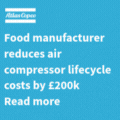
Posted to News on 21st May 2018, 00:00
Air apparent
The electric motor may be the most common source of mechanical power in modern industrial environments, but that doesn’t make it the best solution for every application. David Lockett of Huco Dynatork explains the benefits of an alternative approach, using the power of air.

Amid the buzz surrounding Industry 4.0, or the Fourth Industrial Revolution, it is easy to forget the effect of the technologies that powered the industry’s earlier transformations. The factories of the original industrial revolution were driven first by water and then by steam. Later, the mass production of the second revolution was enabled by electricity, especially by the electric motor, which freed industrial engineers from their dependence on cumbersome belts and shafts, and allowed controllable mechanical power to be delivered anywhere it was required.
Well, almost anywhere. Electric motors remain the prime mover of choice in most industries today, but there are plenty of places where the use of an electric motor is difficult, expensive or even hazardous. Think of wet, dirty process environments, for example, or explosive atmospheres where sparks generated by motors and their associated switchgear present a significant risk of ignition. In these applications, industrial engineers are often forced to adopt alternative technologies. They may install electric motors a safe distance away, for example, and use shafts and other mechanical transmission components to deliver this power where it is needed.
A safer, simpler, and easier alternative in many of these applications is the use of motors powered by compressed air. Air has a host of advantages over other technologies. It won’t ignite flammable atmospheres or contaminate most products. It is easily distributed through simple, low cost pipework and in most production environments it is already widely used and readily available. Moreover, air motors are often smaller for a given power than their electric counterparts, which is a benefit where space is tight.
Modern air motors use one of two alternative technologies. Vane motors operate like a turbine, with bladed wheels that spin in the flow of air caused by a pressure gradient between the inlet and outlet of the motor housing. Vane motors generally operate at high speed and produce low torque, especially when rotating slower than their design speed. That makes them most suitable for applications requiring operation within a relatively narrow speed range.
Piston motors use reciprocating pistons to turn a central shaft, much like a petrol or diesel engine. And piston motors generate maximum torque at start-up, which makes them ideal for applications where frequent stops and starts are required, especially under load. This design offers very high efficiency because the leakage of air through the motor is minimised. Piston motors can consume as much as 80% less air than vane designs with similar power output. Near instantaneous stop-start and reverse also allows very accurate control of the rotary position of the shaft, which is ideal for indexing applications or other automation tasks where precision is required.
Just as important, air motors are simple and reliable. They are not susceptible to overheating or damage if stopped under load. They contain few moving parts and can be specified to meet many motion requirements without the need for complex controls or the addition of reduction gears. Huco’s Dynatork air motor range, for example, offers a speed range of 0 to more than 800 rpm and torque figures up to 15Nm without gear reduction. The motor can be supplied in aluminium, stainless steel or acetal versions. Stainless steel or acetal housings are particularly suited to environments where regular wash-downs are required, with its high resistance to caustic acids and chlorinated sanitisers, acetal is perfectly adapted for use in food and beverage processing.
Since air motors don’t depend on electricity, they don’t generate electromagnetic fields when in use. Special motors produced without magnetic components are used in a number of specialist applications, including MRI scanners, scientific equipment and military applications were the elimination of electromagnetic emissions is a priority.
Applying technology proven over many generations, piston air motors are totally up to date and compatible with Industry 4.0 automation needs. They can be controlled with high accuracy using feedback from either pneumatic or electronic sensors and hence combine well with the latest remote system controls. Dynatork air motors use clean, dry air, produce low noise and with their low air consumption tick all the right boxes for environmental credentials.






